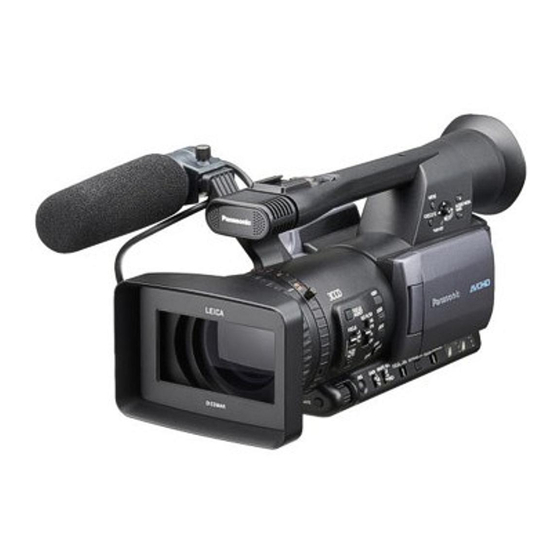Panasonic AG-HMC150 Manual del usuario - Página 33
Navegue en línea o descargue pdf Manual del usuario para Videocámara Panasonic AG-HMC150. Panasonic AG-HMC150 35 páginas. Avchd camcorder
También para Panasonic AG-HMC150: Folleto y especificaciones (8 páginas), Menú de información (20 páginas), Folleto y especificaciones (12 páginas), Folleto (16 páginas), Manual del producto (22 páginas), Instrucciones básicas (20 páginas)

into 24p by the editing software. is can be tricky,
so consult with your teacher before shooting 24pA.
Rack focus. To change the focus of a lens during a
shot in order to call attention to a speci c object or
person. Also called a shift focus or focus pull.
RAW. An image format that consists of the raw image
data collected from an image sensor with little or no
additional processing. Requires processing in post
production for use as an image with proper color
rendition and tonal response. D-SLR cameras
typically offer a RAW mode, and the Red digital
cinema camera provides the equivalent of RAW
images, unlike standard video cameras that record
raw data off the image sensor but then throw away a
substantial amount of image information in the
conversion to a standard video format.
Resolution. e amount of detail in an image.
Higher resolution equals more detail. Also used to
describe the size of an image, usually in pixels, e.g. a
full high de nition video frame consists of 1920 x
1080 pixels, but may also be 1280x720. Standard
de nition is 720 x 480.
Resolution independent. A term to describe
equipment or software that can work in more than
resolution. Some equipment and software work with
only certain video resolutions, but many newer pieces
of equipment and software are resolution
independent (e.g. Final Cut Pro is able to work at
various resolutions including standard de nition
video, high de nition video, and digital lm, e.g.
2K).
Reverse angle, (R/A). A shot where the camera is
placed opposite its position in the previous shot,
"reversing" its view of the scene.
RGB. Red, Green, Blue. e primary colors of light.
Computers, video cameras, scanners, and similar
devices typically process images using separate red,
green, and blue color channels. For example, a three
CCD cameras has a CCD sensors for each primary.
S-Video. A consumer version of component video
that separates the luminance and chrominance of the
video signal to maintain a higher quality picture
compared to composite video.
Sampling frequency. e number of sample
measurements taken from an analog signal in a given
period of time. ese samples are then converted into
numerical values stored in bytes to create the digital
signal.
SD (Secure Digital) is a solid-state memory card
format use in many of the new generation of tapeless
Introduction to the Panasonic AG-HMC150 AVCHD camcorder (rough draft)
cameras. Standard SD cards have a maximum of 4
GB capacity, and high-capacity (SDHC) cards have a
higher limit of 32 GB.
SDTV (also SD). Standard De nition Television. e
new HDTV standards call for a range of different
resolutions. ose that are higher than today's NTSC
are considered HDTV. e ones that are comparable
to NTSC are considered SDTV. Because SDTV is
component and digital it is of higher quality than
NTSC.
Selective focus. See rack focus.
Set-up. e positioning of the camera and lights for
a speci c shot.
Shift focus. See rack focus.
Shooting ratio. e amount of video footage shot
compared to the length of the lm's nal cut.
Shot. A single, continuous run of the camera. e
images recorded by the camera from the time the
camera starts until the time it stops.
Shutter. 1. e mechanical device on a motion
picture camera that shields the lm from light at the
aperture during lming. Some shutters have a
variable angle adjustment allowing the camera
operator to vary the exposure time. e smaller the
shutter angle, the crisper the image and the more
"strobe like" its appearance. Used to good effect in
Saving Private Ryan. Lowering the frame rate of a
lm camera and step printing provides an effect very
similar to show shutter on a video camera, in which
the image update happens less often than 24 times
per second and each frame exhibits motion blur. 2.
On a video camera an electronic device that varies the
effective shutter speed of the camera. Fast shutter
provides crisp frames and the more "strobe like" its
appearance. Slow shutter increases motion blur
providing an effect very similar to lowering the frame
rate and step printing, in other words, a single image
is translated to multiple frames, with the appearance
of motion blur when the camera moves. You have to
experiment with the slow shutter of your video
camera and see the effect for yourself.
Slow motion. Shots photographed faster than the
standard recording speed so that the action on the
screen appears to move slower than normal when
shown at standard speed. See fast motion.
Smash zoom. A fast jarring zoom into a speci c
detail or object in a scene.
Soft focus. Blurring the sharpness of a lm image
with a special lens or a gauze over the lens in order to
http://kino-eye.com/dvb/
33 / 35
